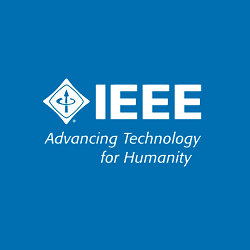دانلود ترجمه مقاله طرح شبکه مش در الگوی دودویی محلی – مجله IEEE
| عنوان فارسی مقاله: | طرح شبکه محلی در مقابل الگوهای دودویی محلی : بازیابی و نمایه سازی تصویر پزشکی |
| عنوان انگلیسی مقاله: | Local Mesh Patterns Versus Local Binary Patterns: Biomedical Image Indexing and Retrieval |
| دانلود مقاله انگلیسی: | برای دانلود رایگان مقاله انگلیسی با فرمت pdf اینجا کلیک نمائید |
| خرید ترجمه آماده: | تماس بگیرید |
| سال انتشار | ۲۰۱۴ |
| تعداد صفحات مقاله انگلیسی | ۱۰ |
| تعداد صفحات ترجمه مقاله | ۱۱ |
| مجله | زیست پزشکی و سلامت انفورماتیک |
| دانشگاه | علوم طبیعی و شورای تحقیقات مهندسی کانادا (NSERC |
| کلمات کلیدی | بازیابی تصویر پزشکی (CBIR)، تبدیل گابور (GT)، الگوری باینری محلی (LBP)، الگوهای مش محلی (LMeP)، بافت. |
| نشریه | IEEE |
| کد مقاله | r1000 |
بخشی از ترجمه:
چکیده
در این مقاله، یک الگوریتم جدید نمایه سازی و بازیابی تصویر با استفاده از الگوهای مش ( مش در الگوی دودویی محلی ) برای استفاده در بازیابی تصویر پزشکی پیشنهاد شده است. الگوریتم باینری محلی استاندارد رابطهی بین پیکسل مرجوعی (مورد نظر) و همسایه های اطراف آن را کدگذاری میکند، در حالیکه روش پیشنهادی رابطه ی میان همسایه های اطراف یک پیکسل مرجوعیِ مشخص در یک تصویر را کدگذاری میکند. روابط ممکن میان همسایه های اطراف به تعداد همسایه ها، P، بستگی دارد. علاوه بر این، کارایی الگوریتم پیشنهادی در این مقاله با ترکیب این الگوریتم با تبدیل گابور اثبات شده است. برای اثبات کارایی این الگوریتم سه آزمایش بر روی سه پایگاه دادهی مختلف تصویر پزشکی پیادهسازی شده است. دو آزمایش از این سه آزمایش برای توموگرافی کامپیوتری (CT) و یک آزمایش برای رزونانس مغناطیسی (MR) بازیابی تصویر انجام میشود. سپس اشاره خواهد شد که پایگاه دادهی مورد نظر برای سه آزمایش عبارتند از: پایگاه دادهی OASIS-MRI، پایگاه دادهی NEMA-CT و پایگاه دادهی VIA/I-ELCAPکه شامل ناحیهی تصاویر CT مورد نظر است. نتایج پس از بررسی بهبود معناداری بر حسب معیارهای ارزیابی آنها در مقایسه با LBP، LBP با تبدیل گابور، و دیگر روشهای فضایی و دامنهی تبدیل نشان داد.
۱٫ مقدمه
الف) انگیزه
برای پرداختن به این مساله، بازیابی تصویر پزشگی مبتنی بر محتوا بوجود آمد. بازیابی تصویر مبتنی بر محتوا (CBIR) از محتواهای تصویری یک تصویر همانند رنگ، بافت، شکل، چهره ها، طرح فضایی و غیره برای بیان و نمایه کردن پایگاه دادهی تصویری استفاده میکند. سیستمهای بازیابی تصویر پزشکی قبلی موجود در [۱]-[۶] ارائه شده اند. استخراج ویژگی در CBIR گام بسیار مهمی است که کارایی آن به روش اتخاذ شده برای استخراج ویژگیهایی از تصاویر معین بستگی دارد. مرور جامع و گسترده ای بر منابع CBIR در [۷]-[۱۱] ارائه شده است.
بخشی از مقاله انگلیسی:
I. INTRODUCTIONA. MotivationTHERE has been a radical expansion of biomedical imagesin medical institutions and hospitals for patient diagnosis.Database for patient diagnosis exists in different formats suchas computer tomography (CT), magnetic resonance imaging(MRI), ultrasound (US), X-ray, etc. However, one cannot makeuse of this data unless it is organized to allow efficient access,search, and retrieval. To address this problem, content-basedbiomedical image retrieval came into existence. The contentbasedimage retrieval (CBIR) utilizes visual contents of an imagesuch as color, texture, shape, faces, spatial layout etc., to representand index the image database. The previously availablebiomedical image retrieval systems are presented in [1]–[۶].The feature extraction in CBIR is a prominent step whoseeffectiveness depends upon the method adopted for extractingManuscript received August 13, 2012; revised February 8, 2013 and June 21,2013; accepted October 24, 2013. Date of publication November 4, 2013; dateof current version May 1, 2014. This work was supported by the Canada ResearchChair program, the Natural Sciences and Engineering Research Councilof Canada (NSERC) Discovery Grant.The authors are with the Computer Vision and Sensing Systems Lab, Departmentof Electrical and Computer Engineering, University ofWindsor,Windsor,ON N9B 3P4, Canada (e-mail: muralasu@uwindsor.ca; jwu@uwindsor.ca).Color versions of one or more of the figures in this paper are available onlineat http://ieeexplore.ieee.org.Digital Object Identifier 10.1109/JBHI.2013.2288522features from given images. Comprehensive and extensive literaturesurvey on CBIR is presented in [7]–[۱۱].The visual content descriptors are either global or local. Aglobal descriptor represents the visual features of the whole image,whereas a local descriptor represents the visual features ofregions or objects to describe the image. Furthermore, these aresubdivided into two categories, spatial and transform domainbasedfeatures. The first approach makes use of pixels (or agroup of adjacent pixels) gray value and the second approachmakes use of transformed data of the gray image for featureextraction.Texture-based biomedical image retrieval is a branch of textureanalysis particularly well suited for the identification ofdisease region, and then retrieval of related documents in thedatabase is making it a star attraction from medical perspective.Cai et al. [12] have used the physiological kinetic featurewhich reduces the image storage memory for positron emissiontomography (PET) image retrieval. Scott and Shyu havedesigned the biomedical media retrieval system [1], where theyutilize the entropy balanced statistical (EBS) k-d tree for featureextraction. The index utilizes statistical properties inherentin large-scale biomedical media databases for efficient andaccurate searches. Rahman et al. [13] have designed the relevancefeedback-based biomedical image retrieval system. Theyhave proposed the query-specific adaptive linear combination ofsimilarity-matching approach by relying on the image classificationand feedback information from users. Nakayama et al. [14]investigated four objective similarity measures as an image retrievaltool for selecting lesions similar to unknown lesions onmammograms. Classification of benign and malignant breastmasses based on shape and texture features in sonography imagesis proposed in [15]. The mass regions were extracted fromthe region of interest (ROI) subimage by implementing a hybridsegmentation approach based on level set algorithms. In [16],a boosting framework for visuality-preserving distance metriclearning is proposed for medical image retrieval. The mammographicimages and dataset from ImageCLEF are used for performanceevaluation. Quellec et al. [17] proposed the optimizedwavelet transform for medical image retrieval by adapting thewavelet basis, within the lifting scheme framework for waveletdecomposition. The weights are assigned between wavelet subbands.They used the diabetic retinopathy and mammographicdatabases for medical image retrieval. The wavelet transformbasedbrain image retrieval is presented in [18]. The cooccurrencematrix-based retrieval of medical CT and MRI images indifferent tissues is can be seen in [19]. Furthermore, the imageretrieval of different body parts is proposed in [20], whichemploy color quantization and wavelet transform.
| عنوان فارسی مقاله: | طرح شبکه محلی در مقابل الگوهای دودویی محلی : بازیابی و نمایه سازی تصویر پزشکی |
| عنوان انگلیسی مقاله: | Local Mesh Patterns Versus Local Binary Patterns: Biomedical Image Indexing and Retrieval |
| دانلود مقاله انگلیسی: | برای دانلود رایگان مقاله انگلیسی با فرمت pdf اینجا کلیک نمائید |
| خرید ترجمه آماده: | تماس بگیرید |


